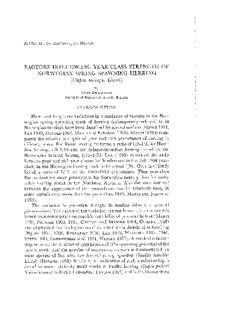| dc.description.abstract | 1. Variation in year-class strength of Norwegian spring spawning
herring is analysed in relation to the structure and the size of the spawning
stock, the location and the time of spawning and environmental conditions
during the egg stage and the early larval development with special
reference to the 1959-1965 year-classes.
2. Stock size estimates were obtained from tagging experiments, and
the number of eggs spawned in each year was calculated from fecundity
data in the literature. The highest figure for the stock size (7.3 million
tons) was found in 1965. The stock size had its lowest figure in 1962
when it was about 2.5 million tons.
3. The location of spawning was determined from the distribution of
catches of spawning and spent herring and from the distribution of newly
hatched larvae. During the period 1959-1965 the most important spawning
took place off Møre, i.e. on the shelf between Stad and Grip, and
mainly in depths of less than 200 m. Spawning south of Bergen was
negligible except in 1959. During the entire period spawning took place
off Halten and Sklinna, whereas spawning at Lofoten was more sporadic.
4. The duration of the spawning season was determined from the
maturity composition of herring collected several times a week during
the spawning season. Off Møre spawning was late in 1962 (15-19 March)
and early in 1965 (28 February-4 March). In 1963 spawning off Lofoten
occurred about two weeks later than off More, and in 1964 three weeks
later, whereas in 1965 spawning took place about simultaneously in the
two regions.
5. The time of main hatching was estimated by adding an incubation
period of generally 18-24 days (depending on the temperature) to the
time of main spawning. Approximate figures for the incubation periods
were obtained from the literature.
6. The distribution of herring larvae during the first month after
hatching was analysed for the period 1959-1965. The larvae were collected
with Clarke-Bumpus plankton samplers in oblique hauls during regular
surveys covering the coastal banks between Stad and Lofoten. Factors
affecting larval abundance estimates are discussed, and a general description
of the vertical distribution and diurnal migration of herring larvae
is given. The geographical distribution of larvae was analysed in relation
to the spawning grounds. The drift of larvae was inferred from subsurface
drogue experiments, wind observations and drift bottle experiments.
Larval length was analysed in relation to the time of spawning. During
the first month after hatcl-ting the larvae were concentrated near the
coast, and almost no larvae were found outside the edge of the shelf. A
more concentrated distribution of larvae was observed in 1961, 1962 and
1965 than in the other years considered, The larvae are transported
northward in coastal water and the force and direction of the wind play
an important role in determining the distribution pattern of larvae.
7. The results indicated that within the range of observed stock sizes
a relationship may exist between the parent stock and abundance of the
resulting year-classes when favourable conditions occurred. However, it
is likely that the year-class strength was determined by a complex of other
factors which completely ruled out the effect of parent stock size in most
of the years. Conditions assumed to be advantageous for the development
of strong year-classes were inferred from the present and other investigations.
Strong year-classes seemed to occur when a combination of the
following conditions existed :
1) widespread distribution of spawning;
2) long duration of the spawning period;
3) a rapid dispersion of larvae from the spawning grounds.
In 1959, 1960, 1963 and 1964, spawning was extensive and prolonged and
with a rapid northward dispersion of larvae from the different spawning
grounds. In 1962 the opposite conditions existed. Spawning was extensive
in 1965 and prolonged in 1961, but the transport conditions during and
after the yolk sac stage resulted in a concentrated distribution pattern.
8. The coincidence in time between the occurrence of suitable food
and hatching of herring larvae is assumed to be the most important
environmental factor controlling year-class strength during the early
larval development. The gradual northward displacement of the main
spawning centre during the last decades probably has increased the
importance of the timing factor, since only two definitely rich year-classes
occurred during the period 1947-1965, namely those of 1950 and 1959. | |
